What Is Warabi-Mochi?
Warabi-mochi is a traditional Japanese confection.
Originally, it was made primarily from the powder obtained from the roots of warabi (a type of fern).
Today, however, other inexpensive starches are often used in place of warabi flour.
Warabi-mochi is clear or translucent and characterized by its soft, jelly-like texture.
It is usually served with kuromitsu (brown sugar molasses) and covered with kinako (ground soybean powder).
Other Japanese sweets similar to warabi-mochi include kuzu-mochi (mochi cakes made with kudzu powder from Western Japan), another type of kuzu-mochi (mochi cakes made with fermented wheat starch from Eastern Japan), and shingen-mochi ("raindrop"-like rice flour mochi cakes).
Kuzu-mochi is made from the powder obtained from the root of the kudzu plant (a perennial plant in the legume family), which is boiled with water and sugar to harden it.
Kuzu-mochi has a clear, elastic and slippery texture.
It is usually topped with kuromitsu syrup and kinako powder, but it can also be flavored with yuzu (aromatic citrus), matcha, or other flavors.

Kuzu-mochi from Eastern Japan features fermented wheat flour.
It is made by steaming the flour after fermentation, and the resulting product is cloudy white with a jiggly, chewy texture.
Kinako powder and kuromitsu syrup are also usually served with this type of kuzu-mochi.
This is a popular confection in the Kanto region.
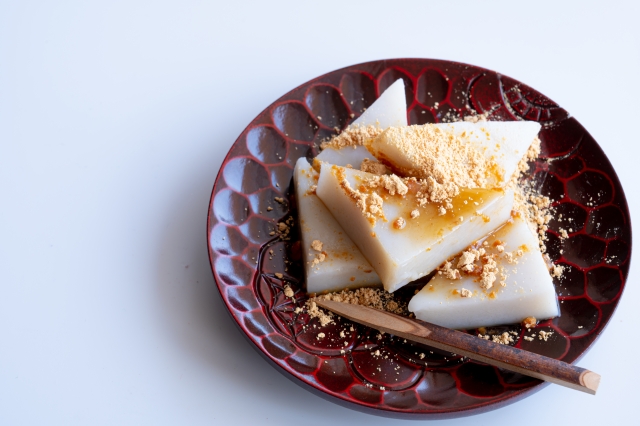
Shingen-mochi is a rice cake made from glutinous rice.
It is characterized by its soft and bouncy texture.
The mochi cake is covered with kinako powder and is commonly eaten with a drizzling of kuromitsu syrup.
This Japanese sweet represents Yamanashi Prefecture and is a popular souvenir for domestic tourists.
It is now available by mail order and has become increasingly popular in recent years.
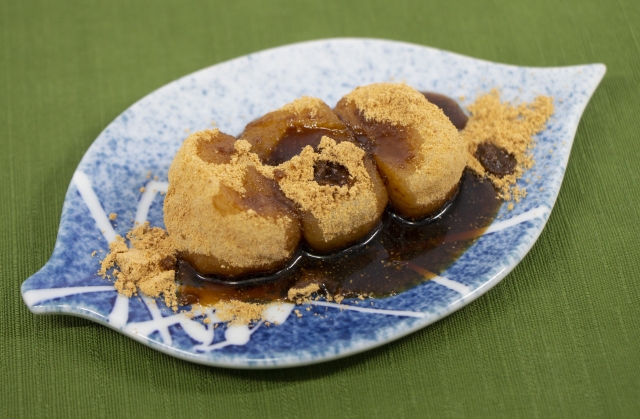
Warabi-mochi and other similar Japanese sweets are well-received in Japan; their varieties and styles are becoming more diverse, including being sold in drinks.
Origins of Warabi Mochi and Its Development as a Traditional Japanese Sweet
The origins of warabi mochi date back to ancient times, when people extracted starch from warabi, a wild bracken plant found in Japan’s mountains and fields, and used it as food. In particular, the starch taken from the underground stems of warabi was extremely precious and treated as a special ingredient since early times.
The prototype of warabi mochi made with warabi starch is believed to have been enjoyed as a cooling summer sweet among the imperial court and aristocrats during the Heian period (794–1185).
Because sugar was rare and valuable at the time, and warabi starch itself was scarce, warabi mochi held the status of a luxury food.
Warabi mochi later spread to the general public during the Edo period (1603–1868).
As sugar became more widely distributed and sweet culture flourished, tea houses began selling warabi mochi, allowing it to take root in everyday life.
From the Meiji to Showa periods (1868 onward), substitute starches such as kudzu and sweet potato starch became more commonly used.
As a result, production became easier, and warabi mochi evolved into a sweet that could be enjoyed throughout Japan.
Through these historical developments, warabi mochi transformed from a “refined summer treat of the nobility” into a “beloved everyday sweet of the people,” and today it is widely enjoyed as one of Japan’s representative traditional desserts.
Types of Warabi-mochi
Let's look at a few different types of warabi-mochi and how to eat them.
Warabi-mochi
The most common type of warabi-mochi.
Warabi-mochi was originally made with warabi powder obtained from the root of the eagle fern.
However, because warabi powder is very expensive and hard to find, it is now used mainly in high-end Japanese confectionery stores.
As a result, warabi-mochi sold today are often made using katakuriko (potato starch) or kudzu flour as a substitute.
This allows people to enjoy a texture resembling warabi-mochi while keeping costs down.
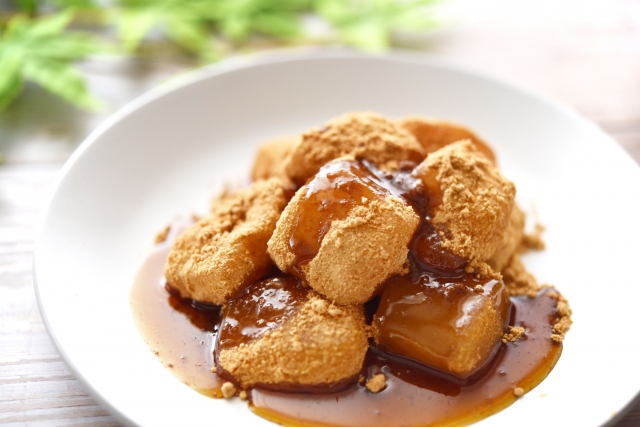
Flavored warabi-mochi
A different type of warabi-mochi can be made by combining other ingredients while making.
Matcha warabi-mochi, kneaded with matcha, offers both the pleasant matcha flavor and mochi cake texture at the same time.
Kokuto warabi-mochi, made with brown sugar, has a deep sweetness and richness.
You can also find warabi-mochi made with fruits like strawberries and mandarin oranges, from those kneaded with fruit juice to those made with fruit wrapped in mochi cakes.
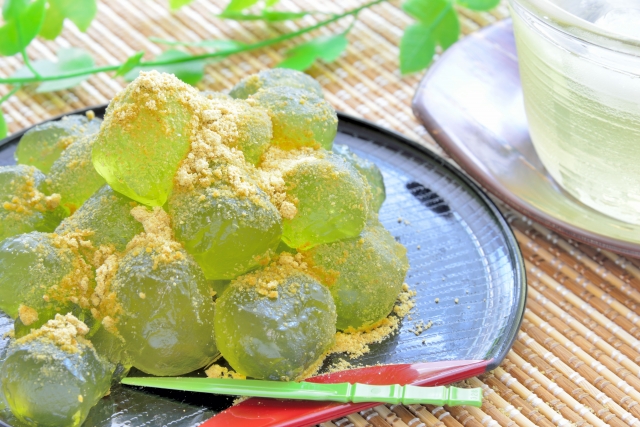
Warabi-mochi ice cream
A dessert of chilled warabi-mochi with ice cream.
Warabi-mochi ice cream is a delightful combination of chewy rice cakes and smooth ice cream.
Vanilla, matcha, and kokuto flavors are often chosen for the ice cream, which are excellent matches with the warabi-mochi.
This dessert is commonly found in kanmidokoro (traditional Japanese-style cafes).
In recent years, it has also become available in convenience stores and supermarkets, making it more accessible.
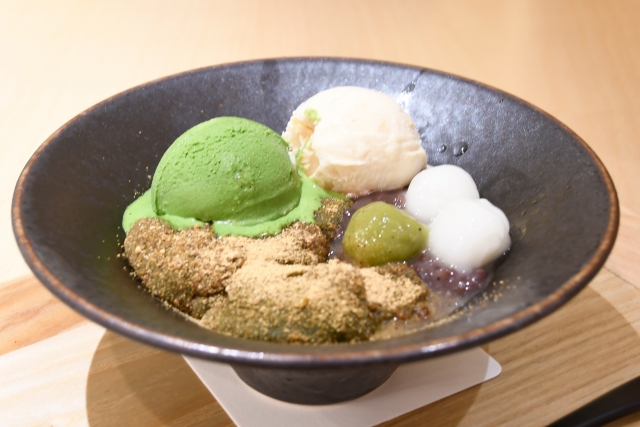
Warabi-mochi juice
Warabi-mochi juice, also known as "drinkable warabi-mochi," is a drink made with warabi-mochi.
It is somewhat reminiscent of bubble tea.
You can enjoy the chewy texture of warabi-mochi as you drink it.
In the drink, matcha, kokuto sugar, and fruit juices are combined with the mochi cakes.
Some shops garnish the drink with whipped cream, as appearance is also an important appeal.
Warabi-mochi juice can be found at warabi-mochi specialty stores and other shops.
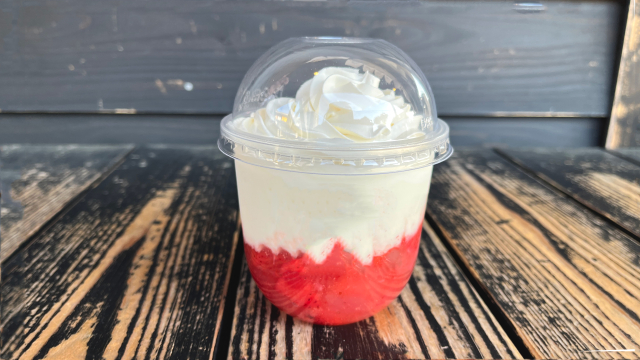
Enjoy the craftsmanship
Below is a recipe for making basic warabi-mochi:
First, mix the warabi powder and sugar.
Add water a little at a time, mixing thoroughly to avoid lumps.
Once thoroughly mixed, heat the mixture.
Place the mixture in a saucepan over medium heat and stir constantly with a wooden spoon.
The mixture is whitish at first, but gradually becomes sticky and clear.
Be careful not to overheat, as it will become too hard.
Turn off the heat when the whole mixture becomes transparent and slightly sticky.
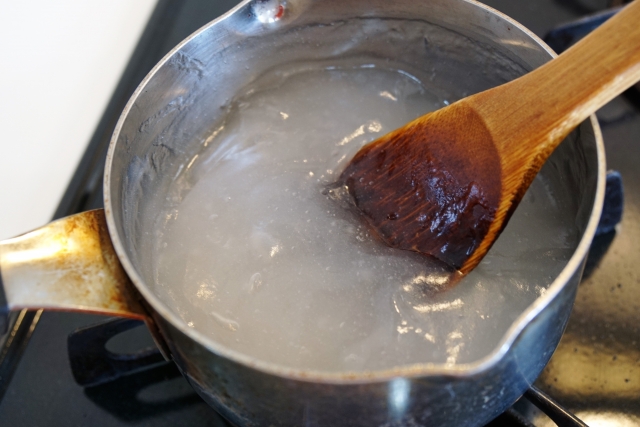
Next, cool down the mixture.
Pour the mixture into another container and smooth the surface.
Place the entire container in cold water.
Allow it to cool until completely chilled and solidified.
Once hardened, remove the cooled warabi-mochi from the container and cut it into bite-sized pieces.
How to eat "warabi-mochi"
The following shows the basic way of eating warabi-mochi:
Sprinkle kinako powder over the warabi-mochi
Cover the warabi mochi with a generous amount of kinako powder.
Pour kokuto syrup over warabi-mochi
Pour kokuto syrup over the warabi-mochi covered with kinako powder.
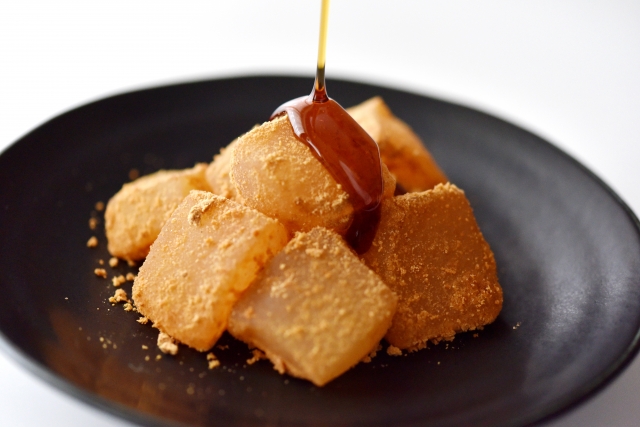
Eat
Use a bamboo skewer or fork.
Remember to avoid scattering the kinako powder while eating.



